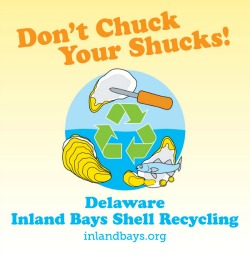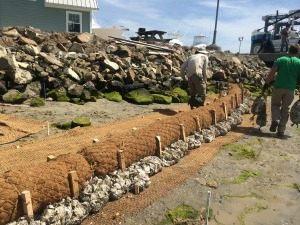
Facebook Twitter Instagram YouTube RSS Feed
Written on: May 30th, 2016 in Living Shorelines

Credit: Delaware Center for Inland Bays
Did you know that empty oyster shells can be reused for wetland restoration projects and that there are two oyster shell recycling programs in Delaware? One is run by the Center for the Inland Bays in Rehoboth Beach and the other is by the Partnership for the Delaware Estuary in Wilmington.
Oysters have hard shells mostly made up of calcium carbonate (the same stuff chalk is made up of), and are perfect for creating natural shoreline stabilization structures that break up wave energy, prevent erosion, and serve as homes for baby oysters, also called spat. In addition to controlling erosion, oysters filter water. One adult oyster can filter up to 50 gallons of water a day.

Indian River living shoreline installation with oyster bags.
One way we’ve utilized this natural resource is in our living shorelines projects. Once the oyster shells have been cured, they are stuffed into mesh bags to keep them from being knocked around and put along the edge of the living shorelines projects (see picture). They serve as a first line of defense for the marsh edge protecting it against strong waves, and also as a blank canvas to attract new oyster colonies.
Remember, as the Center for the Inland Bays says, “Don’t Chuck Your Shucks!”, recycle them to keep them out of landfills and get them back into nature. Currently, Center for Inland Bays and Partnership for the Delaware Estuary collect oyster shells from local restaurants, please contact each program directly for more information about their oyster shell recycling programs.